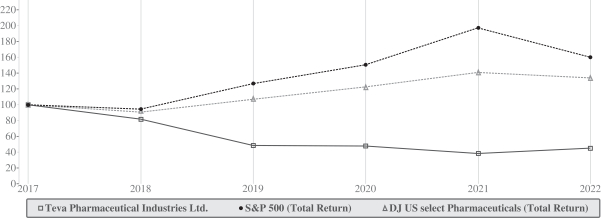2022 Debt Balance and Movements
As of December 31, 2022, our debt was $21,212 million, compared to $23,043 million as of December 31, 2021. This decrease was mainly due to $1,369 million of senior notes repaid at maturity and $484 million of exchange rate fluctuations.
In April 2022, Teva repaid $296 million of its 3.25% senior notes at maturity.
In July 2022, Teva repaid $365 million of its 0.50% senior notes at maturity.
In December 2022, Teva repaid $713 million of its 2.95% senior notes at maturity.
Our debt as of December 31, 2022 was effectively denominated in the following currencies: 62% in U.S. dollars, 36% in euros and 2% in Swiss francs.
The portion of total debt classified as short-term as of December 31, 2022 was 10%, compared to 6% as of December 31, 2021, mainly due to repayment of debt, partially offset by a reclassification of upcoming maturities in 2022.
Our financial leverage, which is the ratio between our debt and the sum of our debt and equity, was 71% as of December 31, 2022, compared to 67% as of December 31, 2021.
Our average debt maturity was approximately 5.8 years as of December 31, 2022, compared to 6.4 years as of December 31, 2021.
For further information, see note 9 to our consolidated financial statements.
2021 Debt Balance and Movements
On February 1, 2021, $491 million of our 0.25% convertible senior debentures, due 2026 were redeemed by holders.
In July 2021, we repaid $1,475 million of our 2.2% senior notes at maturity.
In November 2021, we completed debt issuances for an aggregate principal amount of $5,013 million, comprised of 1,500 million euro principal amount of 4.38% sustainability-linked senior notes due in 2030, 1,100 million euro principal amount of 3.75% sustainability-linked senior notes due in 2027, $1,000 million principal amount of 4.75% sustainability-linked senior notes due in 2027 and $1,000 million principal amount of 5.13% sustainability-linked senior notes due in 2029.
In November 2021, we completed a cash tender offer, which resulted in debt reduction of: $4,008 million from our 1.13% 1,500 million euro senior notes due in October 2024, 1.25% 1,300 million euro senior notes due in March 2023, 3.25% 700 million euro senior notes due in April 2022, 2.8% $3,000 million senior notes due in July 2023 and 2.95% $1,300 million senior notes due in December 2022.
In November 2021, we repaid $613 million and $588 million of our 3.65% senior notes at maturity.
During 2021, we borrowed up to $500 million under our RCF, which was fully repaid before year end.
Total Equity
Total equity was $8,691 million as of December 31, 2022, compared to $11,244 million as of December 31, 2021. This decrease was mainly due to a net loss of $2,406 million and a negative impact of $356 million from exchange rate fluctuations.
72
